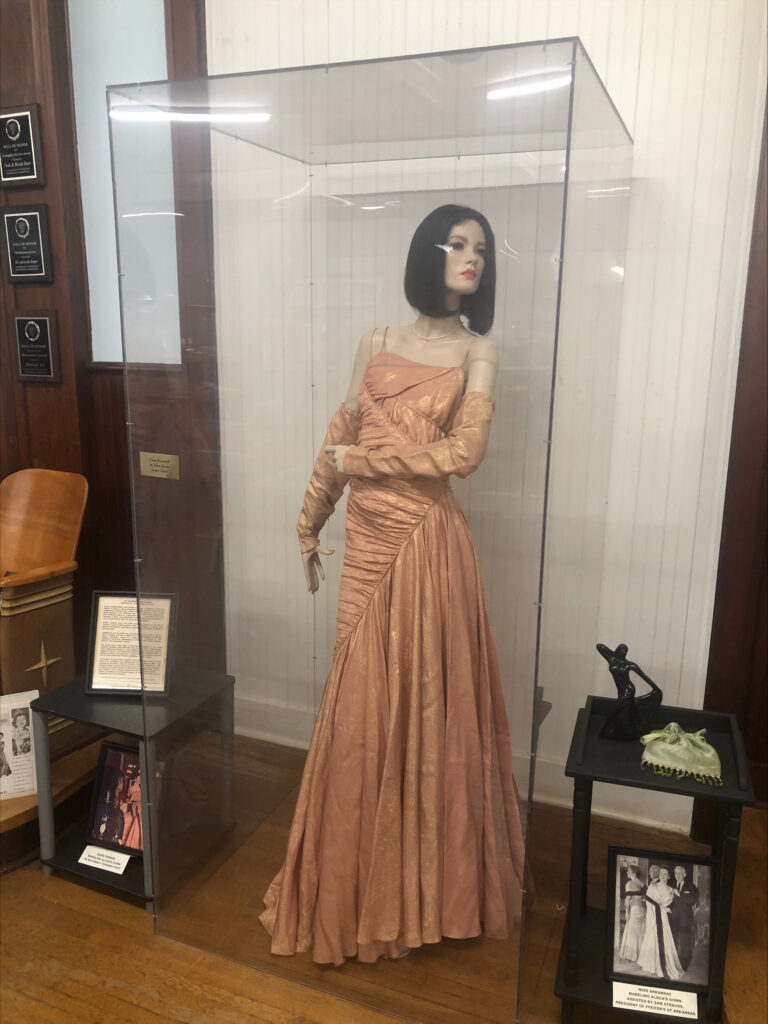The Aluminum Ball Gown

By: Cody Berry
One of the weirdest things that Alcoa made during its heyday was their famous aluminum gown. This special dress was made in 1956 by French designer Jean Desses of Paris. Desses made his dress with “woven aluminum lame,” and 28 yards of “shimmering apricot gold fabric.”1 It was a full-length ball gown that was shirred taut in the torso and fanned out into what the Pick and Shovel newspaper called “diamond points of a swirling skirt,” with a matching stole that was trimmed in mink.
The aluminum cloth Jean Desses used to make the gown was said to be “chiffon-soft,” and “supple enough to be drawn through a wedding ring.”2 Being designed in Paris, it was shown there first, then at the Neiman Marcus Fashion Awards dinner in Dallas. In December 1956, the gown was scheduled to be shown in England and Canada as well. It even made an appearance on the Ed Sullivan Show and on the “Today” program featuring Dave Garroway.3
How was the aluminum cloth made? Sheets of aluminum foil were laminated between layers of plastic, and color was provided by the adhesive used to bond them together. This foil was then “slit at high speed into metallic fibers which are twisted into thread.” That is then woven with other fibers to produce the new fabric. The gown was created as the first in Alcoa’s FORECAST program. The idea was to encourage designers to “interpret the comforts and beauties of tomorrow’s homes.”4 So, it was a bit futuristic at the time.
The aluminum gown was also used to help promote Alcoa at a college football game that was known as the Aluminum Bowl on December 22, 1956. The Aluminum Bowl took place at Little Rock’s War Memorial Stadium between Montana State College and St. Joseph’s College of Indiana, two teams that had nothing to do with Arkansas. The Aluminum Bowl was the first national collegiate championship game in Arkansas and the first racially integrated one.5
The aluminum gown was worn at the Aluminum Bowl by Barbara Banks, who was Miss Arkansas that year. Banks was from Conway. She wore the aluminum gown as she introduced Governor Orval Faubus to the national television audience. The halftime parade featured 25 convertibles and four marching bands. The game itself was a huge disappointment because it rained most of the time, which affected the performance of both teams and at halftime Miss Banks had to be bundled to the neck in a coat to protect the gown. Furthermore, the game ended in a tie, so both teams agreed to share the trophy.6
In 1958, the aluminum gown was worn by Bobby Jo Walker, the reigning Mrs. Florida in the Mrs. America Pageant, sponsored by Alcoa. At some point, the gown was given to former Alcoa employee Roy B. Smith, whose daughter Jayme rescued it from storage and donated it to the Bauxite Historical Museum where it is today.7 It’s a lovely piece of history.

Citations:
1 “Aluminum Ball Gown,” Pick and Shovel, December 1956, p. 6.
2 “Aluminum Ball Gown,” Pick and Shovel, December 1956, p. 6.
3 “Aluminum Ball Gown,” Pick and Shovel, December 1956, p. 6.
4 “Aluminum Ball Gown,” Pick and Shovel, December 1956, p. 6.
5 Ginger Fox English, “The Alcoa Ball Gown: The Rest of the Story,” Miner Memories, p. 126-127, Originally published in The Saline Courier in September 2013. And Paul Edwards, “Aluminum Bowl,” CALS Encyclopedia of Arkansas, https://encyclopediaofarkansas.net/entries/aluminum-bowl-5489/, Date Accessed July 23, 2025.
6 Ginger Fox English, “The Alcoa Ball Gown: The Rest of the Story,” Miner Memories, p. 126-127, Originally published in The Saline Courier in September 2013. And Paul Edwards, “Aluminum Bowl,” CALS Encyclopedia of Arkansas, https://encyclopediaofarkansas.net/entries/aluminum-bowl-5489/, Date Accessed July 23, 2025.
7 Ginger Fox English, “The Alcoa Ball Gown: The Rest of the Story,” Miner Memories, p. 129-130, Originally published in The Saline Courier in September 2013.
